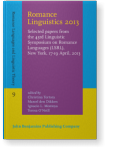On null objects and ellipses in Brazilian Portuguese
Brazilian Portuguese (BP) is known to license anaphoric null objects (ANO), that is, null objects with a linguistic antecedent. It also licenses VP ellipsis (VPE), with auxiliaries, modals and main verbs, the latter a case of V-stranding VPE (V-VPE), the one with which we will be concerned. Although ANOs and V-VPE may have identical surface strings in BP, we propose that they do not have the same structure. To achieve that we examine the properties of the ANOs and compare them to V-VPE, arguing the first are cases of DP ellipsis. We present evidence for an analysis of the ANO as a base-generated empty phrase-marker that will be reconstructed in LF. We also propose that ANOs and VPE are licensed by a lexicalized aspectual head, as a consequence of the loss of generalized verb movement in BP.
References (34)
References
Bianchi, Valentina and Maria Cristina Figueiredo Silva. 1994. “On Some Properties of Agreement-Object in Italian and Brazilian Portuguese.” Issues and Theory in Romance Languages. ed. by Michael Mazzola, 181–190. Washington, DC: Georgetown University Press.
Brito, Ana Maria. 1999. “Concordância, estrutura da frase e movimento do verbo no português europeu, no português brasileiro e no português de Moçambique.” In Lindley Cintra. Homenagem ao homem, ao mestre e ao cidadão. ed. by Isabel H. Faria, 333–365. Lisboa: Cosmos/FLUL.
Chung, Sandra. 2013. “Syntactic Identity in Sluicing: How Much and Why.” Linguistic Inquiry 44: 1–44. 

Costa, João, Maria Lobo, and Carolina Silva. 2010 “Which Category Replaces an Omitted Clitic? The Case of European Portuguese.” Pronouns and Clitics in Early Language. ed. by Pilar Larranaga and Pedro Guijarro-Fuentes, 105–130. Berlin: Mouton de Gruyter
Cyrino, Sonia. 1994. O objeto nulo no português brasileiro—um estudo sintático-diacrônico. PhD Dissertation, University of Campinas.
Cyrino, Sonia. 1997. O objeto nulo no português brasileiro—um estudo sintático-diacrônico. Londrina: Editora da UEL.
Cyrino, Sonia. 2011. Ensaios sobre a sintaxe do objeto nulo no português brasileiro. University of Campinas.
Cyrino, Sonia. 2013b. Null Objects in Brazilian Portuguese Revisited. Paper presented at the Workshop on Brazilian Portuguese. Università Ca’Foscari Venezi. May 2–3, 2013.
Cyrino, Sonia. 2013c. Null Objects and Bare Nominals in Brazilian Portuguese. Paper presented at the Centre de Linguistica Teòrica, Universitat Autònoma de Barcelona.
Cyrino, Sonia and Gabriela Matos. 2002. “VP Ellipsis in European and Brazilian Portuguese—a Comparative Analysis.” Journal of Portuguese Linguistics 1: 177–196.
Cyrino, Sonia and Gabriela Matos. 2005. “Local Licensers and Recovering in VP Ellipsis.” Journal of Portuguese Linguistics 4: 79–112.
Farrell, Patrick. 1990. “Null objects in Brazilian Portuguese.” The Linguistic Review 8: 325–346.
Ferreira, Marcelo Barra. 2000. Argumentos Nulos em Português Brasileiro. M.A. Thesis, University of Campinas.
Fiéis, Alexandra. 2010. “On the Position of sempre in Medieval Portuguese and in Modern European Portuguese.” The Linguistic Review 27: 75–105. 

Fiengo, Robert and Robert May. 1994. Indices and Identity. Cambridge, Mass: MIT Press.
Galves, Charlotte. 1989. “Objet nul et la structure de la proposition en Portugais Brésilien.” Review des Langues Romanes 93: 305–336.
Galves, Charlotte. 1990. “V-Movement, Levels of Representation and the Structure of S.” 13th GLOW Colloquium, University of Cambridge.
Galves, Charlotte. 1994. “V-Movement, Levels of Representation and the Structure of S.” Letras de Hoje 96: 35–58.
Goldberg, Lotus. 2005. Verb-Stranding VP Ellipsis: A Cross-Linguistic Study. PhD Dissertation, McGill University.
Gonzaga, Manuela. 1997. Aspectos da sintaxe do advérbio em português. Dissertação de Mestrado. University of Lisbon.
Gribanova, Vera. 2013. Verb-stranding verb phrase ellipsis and the structure of the Russian verbal complex. Natural Language and Linguistic Theory 31: 91-136. 

Huang, C.-T.J. 1984. “On the Distribution and Reference of Empty Pronouns.” Linguistic Inquiry 15: 531–574.
Kim, Suwon. 1999. Sloppy/Strict Identity, Empty Objects, and NP Ellipsis. Journal of East Asian Linguistics 8: 255–284. 

Lopes, Ruth. 2014. “Null Objects and VP-Ellipsis in Brazilian Portuguese.” Paper presented at the Department of Linguistics Colloquia Series, University of Chicago.
Lopes, Ruth. 2009. “Aspect and the Acquisition of Null Objects in Brazilian Portuguese.” Minimalist Inquiries into Child and Adult Language Acquisition. ed. by Acrisio Pires and Jason Rothman, 105–128. Berlin: Mouton de Gruyter. 

Matos, Gabriela. 1992. Construções de Elipse de Predicado em Português—SV Nulo e Despojamento. PhD Dissertation, University of Lisbon.
Merchant, Jason. 2013. “Diagnosing Ellipsis.” Diagnosing Syntax. ed. by Lisa Lai-Shen Cheng, and Norbert Corver, 537–542. Oxford: Oxford University Press. 

Ohara, Masako. no date. Object Drop in English and in Japanese. [URL].
Raposo, Eduardo. 1986. “On the Null Object in European Portuguese.” Studies in Romance Linguistics. ed. by Osvaldo Jaeggli and Carmen-Silva Corvalán, 373–390. Dordrecht: Foris.
Rouveret, Alain. 2012. “VP Ellipsis, Phases and the Syntax of Morphology.” Natural Language and Linguistic Theory 30: 897–963. 

Cited by (1)
Cited by one other publication
This list is based on CrossRef data as of 25 july 2024. Please note that it may not be complete. Sources presented here have been supplied by the respective publishers.
Any errors therein should be reported to them.
